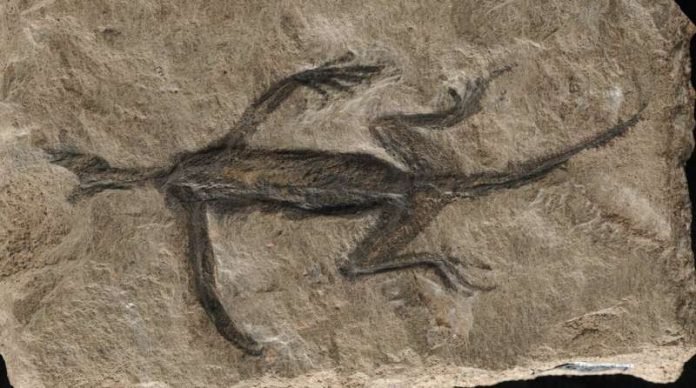
A fossil that puzzled scientists for almost a century has turned out to be part forgery, according to a team led by Dr. Valentina Rossi from University College Cork, Ireland.
Discovered in the Italian Alps in 1931, Tridentinosaurus antiquus was believed to be a crucial link in understanding the evolution of early reptiles.
It was characterized by a distinct dark outline against the rock, which was initially thought to be the preserved soft tissues of the creature. This assumption placed the fossil within the Protorosauria group, a classification of early reptiles.
The recent study, however, published in the journal Palaeontology, uncovers that much of this celebrated preservation was actually black paint on a rock carved to resemble a lizard.
This revelation came after the fossil, which had been extensively mentioned in scientific literature without detailed study, underwent a closer examination.
Dr. Rossi and her team’s investigation revealed discrepancies in the fossil’s appearance, leading to a detailed analysis.
Techniques such as microscopic examination and UV photography showed that the fossil’s texture and composition did not match that of real fossilized soft tissues.
Instead, the entire specimen appeared to have been coated, a common practice in the past to preserve fossils for display.
The hope was that underneath this layer, genuine soft tissues would provide valuable biological insights. Unfortunately, this was not the case.
The study’s findings suggest that the fossil’s detailed outline was artificially added to make it look more impressive, misleading generations of researchers.
The team, which includes experts from the University of Padua, the Museum of Nature South Tyrol, and the Museo delle Scienze in Trento, Italy, now advises caution when using this specimen for future research.
Despite the forgery, the investigation wasn’t entirely in vain. The fossil’s hindlimbs, particularly the femurs, appear to be authentic, albeit in poor condition.
Additionally, the research uncovered the presence of osteoderms, tiny bony scales similar to those found on crocodiles, suggesting the animal may have had these scales on its back.
This intriguing case highlights the importance of modern analytical techniques in paleontology, capable of unraveling mysteries that have baffled scientists for decades.
It serves as a cautionary tale about the assumptions made in scientific research and the necessity of rigorous scrutiny, even of specimens that have been part of scientific discussions for a long time.
The research findings can be found in Palaeontology.
Copyright © 2024 Knowridge Science Report. All rights reserved.



